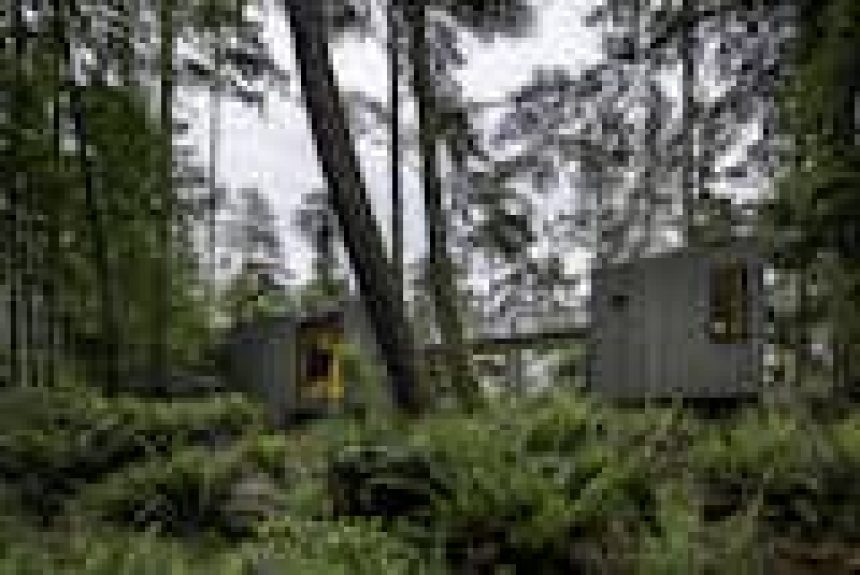Welcome to Prefab Profiles, an ongoing series of interviews with people transforming how we build houses. From prefab tiny houses and modular cabin kits to entire homes ready to ship, their projects represent some of the best ideas in the industry. Do you know a prefab brand that should be on our radar? Get in touch!
Matt Wittman could have been a farmer, having grown up in ranching country in Eastern Washington and Idaho. Instead, he became an architect, but held onto a respect for the utilitarian buildings that defined his childhood. He now combines a reverence for those function-first structures with a modernist ethos, which is a through line at Wittman Estes, the architecture and landscape design firm he cofounded in Seattle in 2012.
Today, the studio is building on early early prefab experiments like a fire station and a solar-power studio with its first modular home concept, Puzzle Prefab. The building system allows for endless custom arrangements, says Wittman, the flexibility a means of minimizing a project’s impact on the surrounding environment while connecting its inhabitants to it as much as possible.
On the heels of the first completed Puzzle Prefab on Whidbey Island in Washington, we chatted with Matt Wittman about the pilot project and how it can reshape how we think about building sustainably.
What qualities make Puzzle Prefab stand apart from other prefab homes?
While prefab houses are sometimes divorced from their context, Puzzle Prefab can be modified according to each site; we can make an infinite variety of shapes and arrangements. This system has the ability to create spaces that can expand or contract for a variety of environments, whether remote, suburban, or urban.
How does the Whidbey Island home take advantage of the building system?
A footprint of 600 square feet of living spaces open out to 557 square feet of covered outdoor spaces. This is nearly a 1:1 ratio of indoor and outdoor space. The temperate climate of the Pacific Northwest enables these outdoor spaces to be an expansion of the interior, which gets the owners closer to nature. This size was determined as “just enough” for the client’s family needs.
How does your construction and installation method minimize impact to a project site?
Much of the construction of the Whidbey Puzzle Prefab happened off-site. The pin foundation system we use meant that there was minimal disturbance and digging in the forest ecology where the home now stands. Hand-set pins reduce site disturbance, so we were able to protect tree roots and reduce the home’s carbon footprint by 77 percent relative to a concrete foundation.
Does the home have additional sustainability features?
The home’s steel columns are structural while also acting as downspouts. Water is stored in a rainwater tank and purified with a custom filtration system, making rainwater safe for use in kitchens, bathrooms, showers, and washing machines, as well as indoor greenhouse irrigation. A 4.1-kW solar array drives a heat pump with hydronic heating and cooling and energy recovery ventilation. Smart-home controls monitor energy use to help residents align heating, cooling, lighting, and ventilation to their comfort.
Which aspects of the design can a client customize?
The spatial configurations of the system’s modules are standard, but the customization happens by selecting and orienting modules in different ways. For example, you could start with a living module and then add multiple sleep/bath modules. You can combine outdoor dining pavilions and energy modules to expand to larger or smaller arrangements. Customization of finishes can happen based on local availability.
Can you augment or relocate a Puzzle Prefab after it’s built?
The modules are self-supporting and rest on a ring beam and the pin foundations. The modules can be removed from the foundations and relocated to new sites. The walkways and canopies we used for the Whidbey Island home are panelized, and can be disassembled and reconfigured elsewhere.
How long can a client expect the design-build process to take after they put down a deposit?
The construction timeline depends on the builder partner. Building more quickly than conventional construction is achieved by parallel construction tracks: preparing the site and foundations at the same time that modules are built off-site.
Where do you build? Could someone across the world construct one of your designs?
The builds can happen anywhere, but some adaptation would be required for the building shells and assemblies. For example, the building assembly for the cold, humid environment on Whidbey Island can be adjusted for a hot, dry desert climate. The finish materials can change based on local availability. The spatial configurations are universal.
What aspects of an install do you manage?
As the architects, we manage design and permitting, and work with local builders who manage the site preparation and utility connections.
Can you provide some context around pricing?
Costs are variable depending on the location of the builder and the time construction begins. The value add for pricing is that the module is built off-site in a controlled environment, and once begun, minimizes changes or unexpected costs. The cost per square foot for the Whidbey Island Puzzle Prefab was $676.
Are you currently building more Puzzle Prefabs?
We are in discussions for several new sites across the Pacific Northwest for the next round of deployment. Remote and hard-to-access locations are of particular interest for clients because the small size is easier to deliver and the houses can be off-grid.















